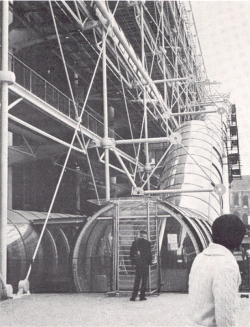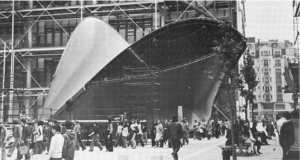Proposal for a National Art Bank
ERNEST SMITH
Some two years ago, Ernest Smith, Director of the Auckland City Art Gallery, and others put forward for consideration by the Caucus a scheme for the establishment in New Zealand of an 'art bank'.
The concept of an art bank is one that will be unfamiliar to most New Zealanders, though several countries (notably Canada) have schemes operating along similar lines. The idea is that the Art Bank would act as a central holding of works by contemporary New Zealand artists. Having purchased or commissioned them, the Art Bank would be in a position to hire them out, nation-wide, to metropolitan and regional art galleries and museums, government departments, local bodies, schools, overseas stations, and so on.
The Art Bank as Mr Smith envisages it would have two major objectives. Firstly: it would sponsor living artists by the purchase of their work, thus helping them to make a living and bringing a wider public into contact with contemporary New Zealand art. Secondly: it is suggested that the scheme would 'provide a stimulus' to the dealer galleries (Mr Smith recognises in his submission that dealer galleries have long made a significant contribution to New Zealand art). As well, it is hoped that the Art Bank would stimulate collecting by private individuals, corporations, and industry.

The new Georges Pompidou National Centre for Art and Culture in the Beaubourg district between the Bastille and Les Halles in Paris. The Centre was designed by Italy's Renzo Pipano and Britain's Richard Roger and reflects concepts of pre-fabrication rather than bricks-and-mortar in museum construction.
The advantages of the present Art Bank scheme, as Mr Smith sees them, are as follows. Economy: the costs are small for a nation-wide project; patronage: this is the most responsible way to assist artists and provide work opportunities; efficiency: the scheme would free large amounts of capital tied up in collections held in storage; encouragement: the scheme would encourage the return of expatriate artists, and reverse the tendency for artists to leave the country for lack of opportunity; de-centralisation: the scheme would implement a deliberate policy of decentralisation of the visual arts, bringing the arts to a wider audience; national resources: the scheme would gradually build up a comprehensive and important up-to-date collection of New Zealand contemporary art; training: the scheme could provide the basis for a national training programme in the handling of art.
The following text is based on an informal interview between Ernest Smith and Peter Webb last August.
Can you tell us how you see an 'art bank' working in a New Zealand context?
The basic idea is to buy paintings which can be hired out to art galleries, public bodies, post-offices, banks - and particularly schools. I imagine that the hireage would be around 10 per cent - fairly nominal, but enough to cover basic operational costs.
Would you envisage that the works bought would cover the whole field of New Zealand art?
Absolutely, yes. Ranging perhaps from small watercolours to major oils and sculpture - also to include later the fine crafts. The distinction between fine art and craft is a very unsound one today. The works bought would constitute a state-owned collection, and as such could be drawn on by all those cities that are now building art centres - art centres which have multi-level potential rather than art galleries - places where you have theatre and so on, a combination of many things, because, you know, that's what the future will have in store for us. Instead of these centres putting large amounts of capital into building up collections they would be able to open their doors with the best of this country's art.
This is a scheme that could replace a new National Gallery. You could almost scrap the whole idea of a new National Gallery and put the collection on the road.
Well, I think, personally, that would be a desirable thing. I'm not saying that we should scrap the National Gallery, but I am saying that the days of a nationally centralised anything (apart from government, and - oh yes, Arts Councils) are, hopefully, over.

The Georges Pompidou Centre, Paris
Do you see Art Bank being closely linked with the functions of a national gallery?
That would be disastrous! I would see Art Bank as not being linked with any gallery. The gallery side should be completely divorced from the art bank. The concept would be destroyed if we started to integrate this kind of project into museum channels. As I see it, Art Bank's main objective - like that of the W.P.A. Federal Art Project, in the United States - is to get artists working, to give them a living, and at the same time to make sure that we do have a very up-to-date collection to be drawn upon.
Do we need both a national gallery and an art bank? Everyone seems to agree that the situation with the existing National Gallery is unsatisfactory. To what extent does the 'art bank' concept replace the idea of a national gallery as a collecting institution?
Well, when you're talking about building a new national gallery. . . if people are not prepared to put their minds twenty years from now, with an option of another twenty years, we might as well forget about it. You could say that art now is in an ephemeral situation; and this being the case, most galleries being built in this country now are actually untruthful exercises, in the sense that they're not taking into account the changes that have taken place over the past two decades. My recent visit to the Pompidou National Centre for Art and Culture in Paris made it clear to me that we are sixty years behind the times in our attitude to the building of art museums in this country. Art is not now confined to canvas and fixed walls and sculpture-pedestals.
What about a gallery's role as a custodian though? It is necessary to look after important works of art from previous periods isn't it? Should the function of the National Gallery be one of looking after the 'old masters' of New Zealand painting?
Well perhaps they could look after those 'old masters'. I'm not thinking of the old masters. My concern is for the encouragement of the next twenty years of New Zealand art - to each his own.
Do you think the art bank could play a role complementary with a national gallery?
An art bank is like any similar agency. It can have its own governing board, made up of liberal people. There would be a central building - maybe a warehouse converted into a storage-cum-viewing area: but not showing exhibitions - that's the big difference. Art galleries exist to display our artistic heritage - art banks disperse their collections. This helps the artists to have their work seen over a wider area of the country. It also helps the private dealers, who have been carrying a load for many years. It will stimulate the buying of art. Canada has an Art Bank, run by the Canada Council, with which I became very familiar when I was an art gallery director there. But it catered only for public buildings at that time.
So, your idea of an art bank in this country is that any provincial gallery could draw on it for, in effect, its entire collection. . .?
Absolutely. Take the exhibition of 'Young Contemporaries' shown at the Auckland City Art Gallery through August 1977: of the works in that, probably one-third would be acceptable to Art Bank. At the end of each year you could put out a book, with reproductions of works, information on them, and an editorial, and every school and library would have an up-to-date source of reference material.
You would obviously need to have a conservation centre attached to Art Bank.
There would be conservators responsible for checking the works. In the short term, the conservation services at Auckland and Dunedin could be called in.
How much do you think Art Bank would cost the country?
I think approximately $300,000 a year for a period of five years would be sufficient. It might cost you $20,000 a year for a warehouse, which would be included in this cost. The only question might be: would you be able to keep up the supply of works? Well, I say you would. Judging from the 'Young Contemporaries' show: I selected something like 77 works from a total of 150 artists. With Art Bank, a young painter might paint, say, seven good paintings in a year, and have the opportunity of selling several of them.
Dealer galleries would obviously look upon this as a mixed blessing. It might mean that, first of all, they would sell more paintings: but then they might be very concerned about Art Bank going directly to the artists. Where does the private gallery really stand in relation to the art bank?
I would think that Art Bank should be able to go to artists' studios. If an artist has been signed up by a dealer then I suppose that the dealer would be entitled to a percentage of the recompense. That's the business of the dealer and the artist concerned.
That's very likely what would happen. Dealers might start signing up their artists.
I think that's a very good idea. Contracts are needed by both parties. It's a very professional approach.
There might be a small problem area there. Clearly this scheme would need. the support of the dealer galleries. After all, at present they do more for the artists than anyone else does.
I think that what is needed at this stage is the support of the artists. If the artists don't want this kind of social progress then the whole exercise would be a waste of time.
Assuming that the artists were in favour, how will it be if the dealer galleries say to them: look, we give you exhibitions. . . you earn your living through us. . . ?
Art bank would not provide a living for them. It would purchase an artist's best works - through a dealer. In the case of an artist not having a dealer, it would be his right to approach Art Bank - that's democracy.
There could be pressure from the dealer galleries on the artists?
That's something the artist would have to bear - as he has to in any case.
Well, you have made a recommendation to Internal Affairs. What about the art community?
The New Zealand Society of Painters and Sculptors has been told about it. I have presented the programme at the annual general meeting of the Art Galleries and Museums Association. It's had favourable feed-back. The thing about the Kiwi system seems to be that if you hear nothing then a thing's likely to be successful. That means it could take from three to twenty years. I don't think we have that much time. We may be in danger of losing artists who would otherwise stay here.
One very pertinent point: who would do the purchasing?
The system would work something like this. The Director of Art Bank would appoint three or four people in a particular area to assist him. These might be: a gallery curator; someone knowledgeable from a university; maybe an art critic or a collector. It shouldn't be the same committee all the time.
What would happen to the Art Bank collection in the long term?
After Art Bank has been collecting for three or four years, you could pick from it the nucleus of perhaps a museum of modern art - maybe in some national park. In maybe five, six, seven years we'll have some idea where the art climate is moving.
